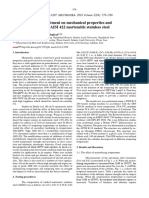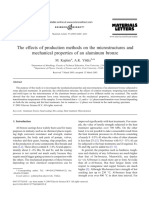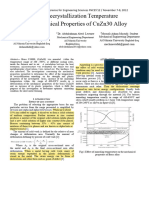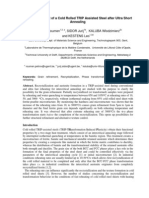Cold Working
Cold Working
Uploaded by
Senanga KeppitipolaCopyright:
Available Formats
Cold Working
Cold Working
Uploaded by
Senanga KeppitipolaOriginal Description:
Copyright
Available Formats
Share this document
Did you find this document useful?
Is this content inappropriate?
Copyright:
Available Formats
Cold Working
Cold Working
Uploaded by
Senanga KeppitipolaCopyright:
Available Formats
Swinburne College, Swinburne University of Technology
Experiments
For
MEE10002
Materials and Processes
Experiment MEE10002-E2
Cold work and annealing of Brass
for
The first year of Engineering
Experiment LMAPR-E2
Cold Work and Annealing of Brass
Experiments for MEE10002 Materials and Processes,
Swinburne College, Swinburne University of Technology
Reference: . Callister, W.D. Jr., Materials Science and Engineering, Wiley N.Y. 8th Ed. 2010,
Chapters 7, 9.
Purpose: To demonstrate the phenomena of cold work and the effect of annealing on brass.
Keywords: cold work, recrystallization, annealing
Prerequisite Knowledge: Basic knowledge of microstructure; hardness testing; heat
treatment; precipitation hardening; annealing; grain size; etching of metals.
Save all your data on a USB data key for later analysis
Introduction
When a metal is deformed at a temperature below its recrystallization temperature (Cold Worked) a
number of properties are changed. In particular its "hardness" (resistance to local plastic deformation) is
increased. If a metal component is being shaped (formed) by cold work then after a certain amount of
cold work, it cannot be further deformed without fracture.
Before further deformation can be carried out the structure must be softened by annealing, which
consists of heating the metal to above its recrystallization temperature (Figure 1).
The cold work and anneal cycle is commonly used in the formation of rolled and drawn components
such as strip and wire.
Figure 1. Schematic illustration of
the effects of recovery,
recrystallization, and grain growth
on mechanical properties and
shape and size of grains. Note the
formation of small new grains
during recrystallization. Source: G.
Sachs in Kalpakjian,S.and Schmid
S.R., Manufacturing Engineering
and Technology, Pearson Prentice
Hall, NJ, 5th ed. 2006
Experiments for MEE10002 Materials and Processes,
Swinburne College, Swinburne University of Technology
Materials 70/30 brass
Five small specimens of brass reduced in thickness (cold rolled) by 60%
are supplied.
Procedure Part A
Annealing
Heat four small brass specimens (cold-rolled by 60%) in the individual furnaces,
(Figure 1), (an annealing treatment)., as follows:
(i) one small brass piece at 200 C, for 20 minutes
(ii) one small brass piece at 400 C, for 20 minutes
(iii) one small brass piece at 540 C, for 20 minutes, and,
(iv) one small brass piece at 660 C for 20 minutes
Figure 2. Heat treatment furnaces Figure 3. Vickers hardness
tester
Experiments for MEE10002 Materials and Processes,
Swinburne College, Swinburne University of Technology
Part B
Hardness testing of 70/30 brass
Five brass reference bars for hardness testing (Vickers Hardness Tester):
:-. One brass bar (no cold work done, as supplied fully annealed), ie no reduction,
-. one brass bar reduced in thickness (cold rolled) by 20%,
-. one brass bar reduced in thickness (cold rolled) by 40%,
-.one brass bar reduced in thickness (cold rolled) by 60%
-. one brass bar reduced in thickness (cold rolled) by 80%.
Hardness Testing Procedure
Whilst the four brass samples from Part A are being annealed
measure the Vickers Hardness (HV (10)) of the five brass reference bars using the Vickers
hardness tester with a load of 10 kg.
Remove the four small brass pieces from the furnaces and quench them in water to room
temperature. (This is known as solution treatment, and is to prevent precipitation hardening
from occurring).
Place each quenched sample into a holding tray which is marked (for reference) at the annealing
temperatures, i.e. 200 C, 400 C, 540 C and 660 C.
Grind both sides of the heat treated brass samples to #220 grit on the polishing machines.
Continue to grind one side only in stages using the #400, #800 and #1200 grit grinding pads.
Clean samples by washing in water and polish the #1200 grit ground side using the diamond
paste polishing pad for 30 seconds. Clean with kerosene, and then wash the kerosene off with
alcohol.
Blow-dry the samples using the hair dryer and place each one back into its holding tray.
Measure the hardness HV (10) of all the heat treated brass samples using the Vickers hardness
tester with a load of 10 kg on the side opposite the polished side (i.e. on the ground side).
Etch the four samples in 50% HNO for about 10-15 seconds each, Rinse in clean water, and
then blow-dry the samples.
Place the dry samples back into their holding tray.
Place each sample of brass (which has been polished and etched) onto the metallurgical
microscope.
Take an image of the surface of each sample using the digital camera. Save your images to -
your USB key
When all four samples have been imaged compare the images. Save your images to your USB
key.
Estimate the grain size of theses brass samples using comparison ASTM charts supplied at 100
magnification.
Compare the microstructures and note any changes in grain shape or appearance.
Experiments for MEE10002 Materials and Processes,
Swinburne College, Swinburne University of Technology
EXPERIMENT LMAPR-E2: Cold Work and Annealing of Brass
Fill out the sections in the Tables:
Percent cold reduction. vs. hardness (Table 1)
annealing temperature vs. hardness ((Table 2)
annealing temperature vs. gain size ((Table 3)
Table 1. Percent cold Reduction versus Hardness
Percent Cold Reduction Hardness HV (10kg)
HV(10)
Original sample
20 %
40 %
60 %
80 %
Percentage cold work versus hardness
Experiments for MEE10002 Materials and Processes,
Swinburne College, Swinburne University of Technology
Table 2. Annealing Temperature versus Hardness (heat treated specimens)
Annealing Temperature (Celsius) Hardness HV (10kg)
200 C
400 C
540 C
660 C
Annealing Temperature versus hardness
Estimate the recrystallization temperature (degrees C) = ?
Experiments for MEE10002 Materials and Processes,
Swinburne College, Swinburne University of Technology
Table 3. Annealing Temperature versus Grain Size
Annealing Grain Size (mm) Grain shape
Temperature (Celsius)
200 C
400 C
540 C
660 C
Annealing temperature versus grain size
Experiments for MEE10002 Materials and Processes,
Swinburne College, Swinburne University of Technology
Save your images to your USB key.
Compare the four sample images.
Sketch the heat treated brass microstructure as it appears in the microscope.
Brass microstructure Brass microstructure
Annealing Temperature Annealing Temperature
200°C 400°C
Brass microstructure Brass microstructure
Annealing Temperature Annealing Temperature
540°C 660°C
Experiments for MEE10002 Materials and Processes,
Swinburne College, Swinburne University of Technology
1. Explain why increasing the amount of cold working increases the hardness of the brass
samples. In your discussion detail what happens to the number of dislocations and how this affects the
hardness.
…………………………………………………………………………………………………………………………
…………………………………………………………………………………………………………………………
…………………………………………………………………………………………………………………………
…………………………………………………………………………………………………………………………
…………………………………………………………………………………………………………………………
…………………………………………………………………………………………………………………………
…………………………………………………………………………………………………………………………
…………………………………………………………………………………………………………………………
…………………………………………………………………………………………………………………………
…………………………………………………………………………………………………………………………
…………………………………………………………………………………………………………………………
…………………………………………………………………………………………………………………………
…………………………………………………………………………………………………………………………
…………………………………………………………………………………………………………………………
…………………………………………………………………………………………………………………………
…………………………………………………………………………………………………………………………
…………………………………………………………………………………………………………………………
…………………………………………………………………………………………………………………………
…………………………………………………………………………………………………………………………
…………………………………………………………………………………………………………………………
…………………………………………………………………………………………………………………………
…………………………………………………………………………………………………………………………
…………………………………………………………………………………………………………………………
…………………………………………………………………………………………………………………………
…………………………………………………………………………………………………………………………
…………………………………………………………………………………………………………………………
…………………………………………………………………………………………………………………………
…………………………………………………………………………………………………………………………
Experiments for MEE10002 Materials and Processes,
Swinburne College, Swinburne University of Technology
2. Explain how heat treating (Annealing) can reverse the effects of cold working, in your
explanation detail the three stages of heat treatment
…………………………………………………………………………………………………………………………
…………………………………………………………………………………………………………………………
…………………………………………………………………………………………………………………………
…………………………………………………………………………………………………………………………
…………………………………………………………………………………………………………………………
…………………………………………………………………………………………………………………………
…………………………………………………………………………………………………………………………
…………………………………………………………………………………………………………………………
…………………………………………………………………………………………………………………………
…………………………………………………………………………………………………………………………
…………………………………………………………………………………………………………………………
…………………………………………………………………………………………………………………………
…………………………………………………………………………………………………………………………
…………………………………………………………………………………………………………………………
…………………………………………………………………………………………………………………………
…………………………………………………………………………………………………………………………
…………………………………………………………………………………………………………………………
…………………………………………………………………………………………………………………………
…………………………………………………………………………………………………………………………
…………………………………………………………………………………………………………………………
…………………………………………………………………………………………………………………………
…………………………………………………………………………………………………………………………
…………………………………………………………………………………………………………………………
…………………………………………………………………………………………………………………………
…………………………………………………………………………………………………………………………
…………………………………………………………………………………………………………………………
…………………………………………………………………………………………………………………………
…………………………………………………………………………………………………………………………
Experiments for MEE10002 Materials and Processes,
You might also like
- Module 1 16 - IIWDocument1,119 pagesModule 1 16 - IIWsree100% (1)
- Hitchiner-Casting Granite Into Gold, The History of Hitchiner's First Fifty YearsDocument32 pagesHitchiner-Casting Granite Into Gold, The History of Hitchiner's First Fifty Yearsjavo0128No ratings yet
- Effect of Magnesium Content On The Ageing Behaviour of Water-Chilled AI-Si-Cu-Mg-Fe-Mn (380) Alloy CastingsDocument10 pagesEffect of Magnesium Content On The Ageing Behaviour of Water-Chilled AI-Si-Cu-Mg-Fe-Mn (380) Alloy CastingsVictor WatanabeNo ratings yet
- Effect of Sensitization On Microhardness and Corrosion Resistance of Austenitic Stainless SteelDocument4 pagesEffect of Sensitization On Microhardness and Corrosion Resistance of Austenitic Stainless SteelIJOCAASNo ratings yet
- The Art of The Goldsmith and Jeweller - Wigley 1898Document332 pagesThe Art of The Goldsmith and Jeweller - Wigley 1898Cintia Lavaissieri100% (1)
- 8 Ee 1Document5 pages8 Ee 1d3xterNo ratings yet
- Effect of Austenitizing Temperature and Cooling Rate On The Structure and Properties of A Ultrahigh Strength Low Alloy SteelDocument10 pagesEffect of Austenitizing Temperature and Cooling Rate On The Structure and Properties of A Ultrahigh Strength Low Alloy SteelMilena StajicNo ratings yet
- Sae 1025Document6 pagesSae 1025Mada PerwiraNo ratings yet
- Effect of Heat Treatment On The Fracture Toughness of AISI 4140 SteelDocument6 pagesEffect of Heat Treatment On The Fracture Toughness of AISI 4140 Steelou82muchNo ratings yet
- Effect of Tempering Temperature On Microstructure and Mechanical Properties of AISI 6150 SteelDocument5 pagesEffect of Tempering Temperature On Microstructure and Mechanical Properties of AISI 6150 SteelCường BéoNo ratings yet
- Effect of Tempering Temperature and Time On StrengDocument11 pagesEffect of Tempering Temperature and Time On StrengMauri RangelNo ratings yet
- Jsa 202Document9 pagesJsa 202XanmanNo ratings yet
- Experimental Correlation of Microstructures With Jominy TestDocument14 pagesExperimental Correlation of Microstructures With Jominy TestDaniel Urincho MaldonadoNo ratings yet
- Temper EmbrittlementDocument5 pagesTemper EmbrittlementClaudia Patricia Magaña RabanalesNo ratings yet
- Analysis of Tensile Strength and Hardness of IS 500/7 Grade Ductile Iron Subjected To Austempering Heat TreatmentDocument4 pagesAnalysis of Tensile Strength and Hardness of IS 500/7 Grade Ductile Iron Subjected To Austempering Heat TreatmentWasim ShaikNo ratings yet
- Srivastav A 2021Document7 pagesSrivastav A 2021adam kurniawanNo ratings yet
- Structural Transformations During Tempering in The PDFDocument5 pagesStructural Transformations During Tempering in The PDFConstantin Anghelina PuiuNo ratings yet
- Wear Behavior of 100cr6-PolatDocument6 pagesWear Behavior of 100cr6-PolatAntonioNo ratings yet
- 1 s2.0 S0925838810031683 MainDocument6 pages1 s2.0 S0925838810031683 MainMehtap KuzuNo ratings yet
- NaCl Effect 2Document7 pagesNaCl Effect 2Aashima sharmaNo ratings yet
- Application of EIS To The Study of Corrosion Behaviour of Sintered Ferritic Stainless Steels Before and After High-Temperature ExposureDocument8 pagesApplication of EIS To The Study of Corrosion Behaviour of Sintered Ferritic Stainless Steels Before and After High-Temperature ExposuremadacursaruNo ratings yet
- The Effects of Production Methods On The Microstructures and Mechanical Properties of An Aluminum BronzeDocument10 pagesThe Effects of Production Methods On The Microstructures and Mechanical Properties of An Aluminum BronzeFathia AlkelaeNo ratings yet
- Technological Advances in Steels Heat Treatment: Izabel Fernanda MachadoDocument5 pagesTechnological Advances in Steels Heat Treatment: Izabel Fernanda MachadoMaria MantillaNo ratings yet
- Effects of Heat Treatment On The Mechanical and Microstructural Properties of Improvable SteelDocument6 pagesEffects of Heat Treatment On The Mechanical and Microstructural Properties of Improvable SteelLinh QuanNo ratings yet
- Sample 1020Document8 pagesSample 1020Shahroz QureshiNo ratings yet
- Effects of Recrystallization Temperature On CuZn30Document6 pagesEffects of Recrystallization Temperature On CuZn30Hakan KuşdemirNo ratings yet
- Annealing Test 1Document14 pagesAnnealing Test 1Andy Tan WXNo ratings yet
- Effect of Cryogenic Rolling and Annealing On The Microstructure Evolution and Mechanical Properties of 304 Stainless SteelDocument8 pagesEffect of Cryogenic Rolling and Annealing On The Microstructure Evolution and Mechanical Properties of 304 Stainless SteelNathanael Basana HisarNo ratings yet
- Recrystallization 6005Document7 pagesRecrystallization 6005lindberghsoslNo ratings yet
- An Investigation of The Abrasive Wear Behavior of Ductile CaDocument6 pagesAn Investigation of The Abrasive Wear Behavior of Ductile CalucianoNo ratings yet
- Magnetic NDE Characterization of Tempered 2.25Cr-1Mo SteelDocument19 pagesMagnetic NDE Characterization of Tempered 2.25Cr-1Mo SteelApoorv KrishnaNo ratings yet
- Materials 13 00172Document11 pagesMaterials 13 00172vasundhara singhNo ratings yet
- Effect of Heat Treatment and Mechanical Characterization of Aisi 4140 SteelDocument8 pagesEffect of Heat Treatment and Mechanical Characterization of Aisi 4140 SteelTJPRC PublicationsNo ratings yet
- Microstructure and Mechanical Properties of A Microalloyed Steel After Thermal TreatmentsDocument5 pagesMicrostructure and Mechanical Properties of A Microalloyed Steel After Thermal Treatmentsputra sriNo ratings yet
- Asanovic, 2004Document7 pagesAsanovic, 2004Muhammad Falqi YusufNo ratings yet
- Lab 1 Final'Document7 pagesLab 1 Final'anandohalder12No ratings yet
- Effects of Various Double-Quenching Treatments On The Microstructure andDocument12 pagesEffects of Various Double-Quenching Treatments On The Microstructure andJarek PlaszczycaNo ratings yet
- PETROV Roumen, SIDOR Jurij, KALUBA Wlodzimierz and KESTENS LeoDocument6 pagesPETROV Roumen, SIDOR Jurij, KALUBA Wlodzimierz and KESTENS LeoRoumen PetrovNo ratings yet
- The Influence of Natural Aging and Pre-Aging On The Mechanical, Physical and Microstructural Properties of The en Aw-6060 Aluminum AlloyDocument3 pagesThe Influence of Natural Aging and Pre-Aging On The Mechanical, Physical and Microstructural Properties of The en Aw-6060 Aluminum AlloyPavan KumarNo ratings yet
- Your Name: Ulises Jose Corona Name of The Course: MAE2160 Materials Science Lab Date: Report DateDocument7 pagesYour Name: Ulises Jose Corona Name of The Course: MAE2160 Materials Science Lab Date: Report DateUlises Corona100% (4)
- Sensitization of AISI 304 and Reversing of Corrosion 2012Document13 pagesSensitization of AISI 304 and Reversing of Corrosion 2012Adnan SaadiNo ratings yet
- 1 s2.0 S1044580308003422 MainDocument6 pages1 s2.0 S1044580308003422 MainRafaelNo ratings yet
- Quench Hardening and Mechanical Characterization of Aisi 4140 SteelDocument6 pagesQuench Hardening and Mechanical Characterization of Aisi 4140 SteelTJPRC PublicationsNo ratings yet
- 2017 - AIP BalkayaDocument8 pages2017 - AIP BalkayawarnoiseNo ratings yet
- Precipitation Hardening in Aluminum Alloy 6022: W.F. Miao and D.E. LaughlinDocument6 pagesPrecipitation Hardening in Aluminum Alloy 6022: W.F. Miao and D.E. LaughlinKayode Remi-OlaniyanNo ratings yet
- Effect of Charpy Impact Test On Microstructure ProDocument8 pagesEffect of Charpy Impact Test On Microstructure ProJacques OosthuizenNo ratings yet
- Microstructure and Mechanical Properties of 0.63C-12.7Cr Martensitic Stainless SteelDocument6 pagesMicrostructure and Mechanical Properties of 0.63C-12.7Cr Martensitic Stainless SteelJim SmithNo ratings yet
- Mechanical Properties of Dual Phase Steel Quenched in BitumenDocument16 pagesMechanical Properties of Dual Phase Steel Quenched in BitumenSiddharth VibhuteNo ratings yet
- En8 CharpyDocument10 pagesEn8 CharpyfailureanalystNo ratings yet
- Erdem 2005Document7 pagesErdem 2005vinayakNo ratings yet
- Stress Corrsion Cracking Behavion of Austenitic Stainless Steel PDFDocument5 pagesStress Corrsion Cracking Behavion of Austenitic Stainless Steel PDFJEISON CONTRERAS HOYOSNo ratings yet
- Laboratory 3Document9 pagesLaboratory 3Salar SalahiNo ratings yet
- 002 Hardness and Impact Toughness of Niobium Alloyed Austempered Ductile IronDocument5 pages002 Hardness and Impact Toughness of Niobium Alloyed Austempered Ductile IronWilson SCKUDLAREKNo ratings yet
- Behaviour of Structural Carbon Steel at High Temperatures PDFDocument10 pagesBehaviour of Structural Carbon Steel at High Temperatures PDFAlex GigenaNo ratings yet
- Optimization in Spheroidized Annealing of Two AISI 1022 Low Carbon Steels Used in Bolt IndustryDocument7 pagesOptimization in Spheroidized Annealing of Two AISI 1022 Low Carbon Steels Used in Bolt Industryenrico susantoNo ratings yet
- Jurnal Chung Effect of Aging On CuZnAl Shape Memory With MN AdditionDocument6 pagesJurnal Chung Effect of Aging On CuZnAl Shape Memory With MN AdditionMuhammad Falqi YusufNo ratings yet
- Ojay 1ST Publication PDFDocument16 pagesOjay 1ST Publication PDFvenkatrangan2003No ratings yet
- Effect of Heat Treatment On Microstructure and Hardness of Steel 67sicr5Document7 pagesEffect of Heat Treatment On Microstructure and Hardness of Steel 67sicr5ZarikhNo ratings yet
- Effect of Heat Treatment and MechanicalDocument8 pagesEffect of Heat Treatment and MechanicalVieri AnggoroNo ratings yet
- Metals: Effect of Low-Temperature Sensitization On Hydrogen Embrittlement of 301 Stainless SteelDocument12 pagesMetals: Effect of Low-Temperature Sensitization On Hydrogen Embrittlement of 301 Stainless SteelVenu PrasadNo ratings yet
- A.kishore Journal PaperDocument34 pagesA.kishore Journal PaperA KishoreNo ratings yet
- Ceramic Materials for Energy Applications V: A Collection of Papers Presented at the 39th International Conference on Advanced Ceramics and CompositesFrom EverandCeramic Materials for Energy Applications V: A Collection of Papers Presented at the 39th International Conference on Advanced Ceramics and CompositesJosef MatyášNo ratings yet
- Microstructures and Fatigue Crack Growth of EH36 TMCP Steel WeldmentsDocument8 pagesMicrostructures and Fatigue Crack Growth of EH36 TMCP Steel WeldmentsJohan Esteban Garcia PuentesNo ratings yet
- Astm A194 Grade 16 Heavy Hex NutsDocument1 pageAstm A194 Grade 16 Heavy Hex NutsCostas AggelidisNo ratings yet
- Effect of The Heat Treatment On The Microstructure and Mechanical Properties of Medium-Mn-SteelsDocument10 pagesEffect of The Heat Treatment On The Microstructure and Mechanical Properties of Medium-Mn-SteelsFernando BarreraNo ratings yet
- Damascus SteelDocument15 pagesDamascus SteelKonstantinos TheodosiadisNo ratings yet
- Aluminum Base AlloysDocument15 pagesAluminum Base AlloysDaruzboyNo ratings yet
- Unit 1: 13 Marks Questions: Anna University QuestionsDocument4 pagesUnit 1: 13 Marks Questions: Anna University Questions10BShalini.B IgmmNo ratings yet
- Heat Treatment Lecture NotesDocument48 pagesHeat Treatment Lecture Notes22210021 TANWADE RUTURAJ RAVINDRANo ratings yet
- Introduction To Surface Hardening of SteelsDocument5 pagesIntroduction To Surface Hardening of SteelsroseNo ratings yet
- To PM Technology: A Guide For Designers and EngineersDocument30 pagesTo PM Technology: A Guide For Designers and EngineersBasliu DoinaNo ratings yet
- Chloride Induced Stress Corrosion Cracking (CISCC) in PipelinesDocument6 pagesChloride Induced Stress Corrosion Cracking (CISCC) in PipelinesMohamed AtefNo ratings yet
- Nigel Faranando EMR2102 Assignment 2Document7 pagesNigel Faranando EMR2102 Assignment 2Isaiah MakurunjeNo ratings yet
- Exercises Topic 4 Heat TreatmentsDocument14 pagesExercises Topic 4 Heat TreatmentsClara Barbero SánchezNo ratings yet
- ASTM and Grain Size MeasurementsDocument6 pagesASTM and Grain Size MeasurementsTomy George100% (1)
- Metal Casting Principles and TechniquesDocument6 pagesMetal Casting Principles and TechniquesChandra Wahyu SetiawanNo ratings yet
- MM 357 - Ceramics and Powder MetallurgyDocument9 pagesMM 357 - Ceramics and Powder MetallurgyVikas MeenaNo ratings yet
- Grade Grade Code StandardDocument18 pagesGrade Grade Code StandardOmkar NikamNo ratings yet
- TCI-link FittingsDocument24 pagesTCI-link FittingsOresteHernandezNo ratings yet
- 4.0 Metal Alloys, Their Structure and Strengthing by Heat TreatmentDocument33 pages4.0 Metal Alloys, Their Structure and Strengthing by Heat TreatmentAbdul RashidNo ratings yet
- CPM20CV Data SheetDocument2 pagesCPM20CV Data SheetAndi BondocNo ratings yet
- Conector AmerlineDocument25 pagesConector AmerlineCesar MarquesNo ratings yet
- Mechanical EngineeringDocument15 pagesMechanical EngineeringAnonymous mqIqN5zNo ratings yet
- Karat Vs Carat - Google SearchDocument1 pageKarat Vs Carat - Google SearchGeoff RasheNo ratings yet
- 35 Different Types of Engineering DegreesDocument14 pages35 Different Types of Engineering DegreesLiannKwonNo ratings yet
- Welcome To Amrita Academic Management Suite Home - .Document5 pagesWelcome To Amrita Academic Management Suite Home - .HARSHAVARDHAN MADISHETTINo ratings yet
- Foundry TechnologyDocument28 pagesFoundry TechnologyVp Hari NandanNo ratings yet
- 7Document8 pages7Milena StajicNo ratings yet
- The Engineering Behind The Mechanical Properties Enhancement On Hsla Steels, Microalloyed With Niobium: Effects of Boron and TitaniumDocument8 pagesThe Engineering Behind The Mechanical Properties Enhancement On Hsla Steels, Microalloyed With Niobium: Effects of Boron and TitaniumRogério DiasNo ratings yet

























































































